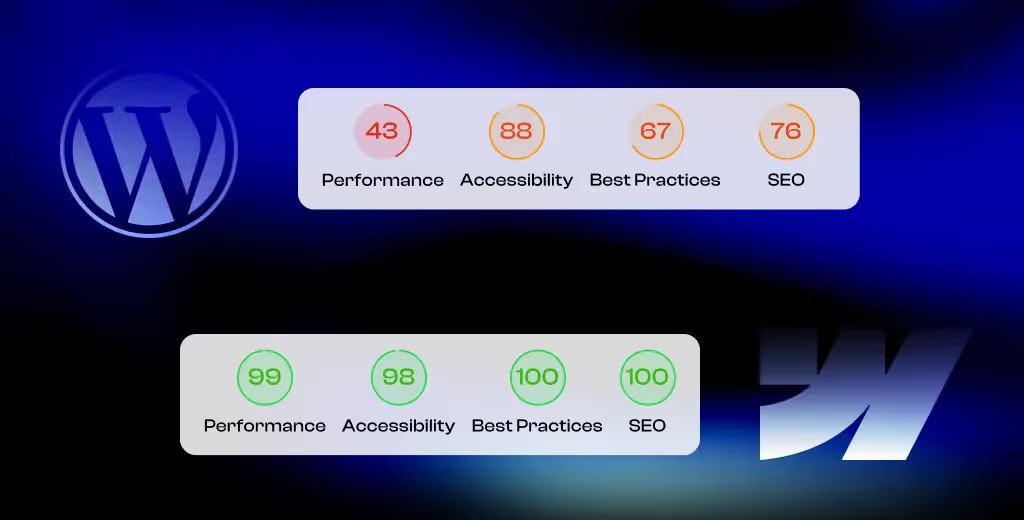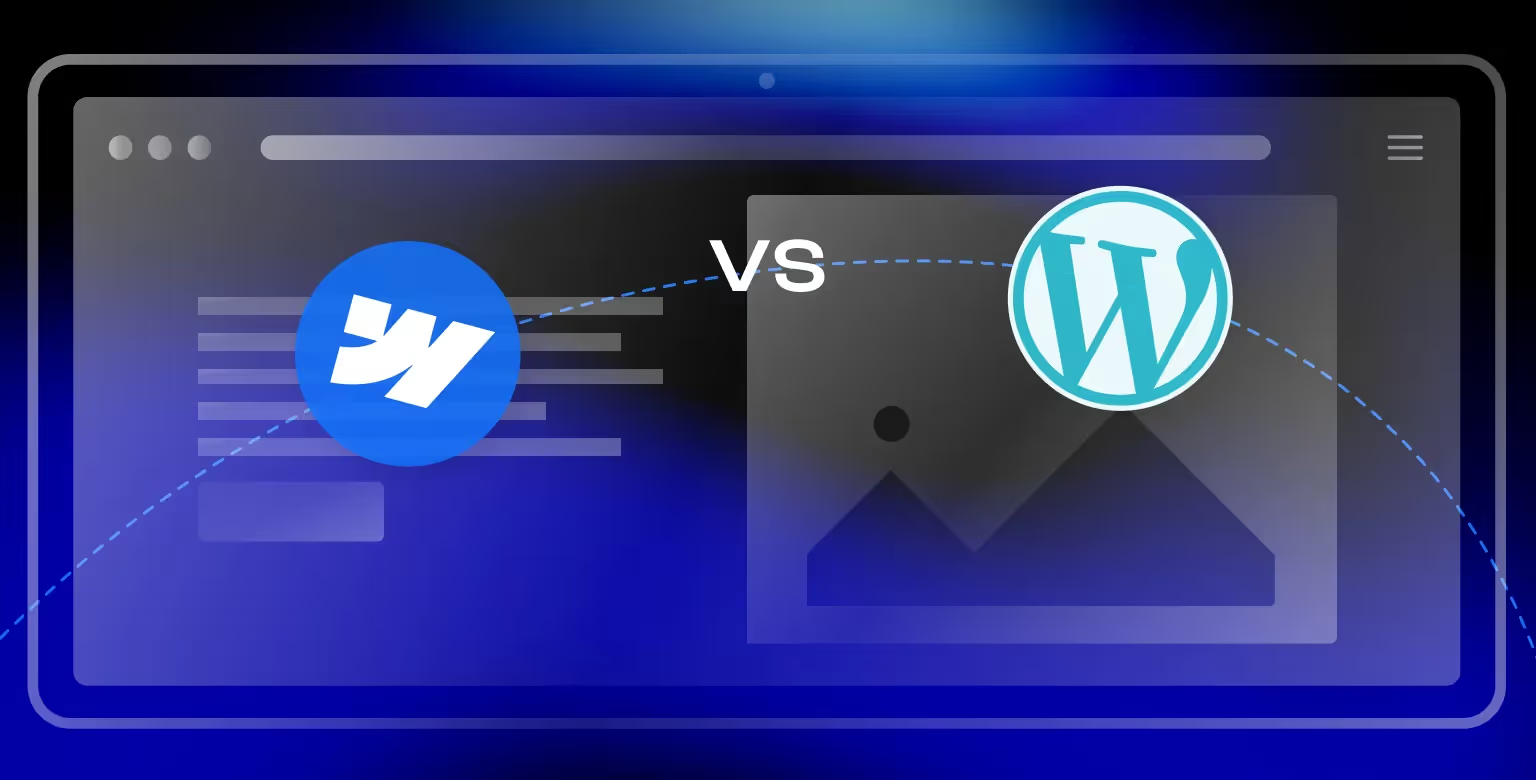When it comes to building a website, the first decision you’ll face is choosing the right platform. This choice can feel like navigating a maze, there are countless options, each with its own strengths and quirks.
Today, we’re putting two of the most popular platforms head-to-head: Webflow and WordPress. Both are excellent tools, but their differences make them better suited to different types of projects and users.
Whether you’re a designer, developer, business owner, or just someone looking to get a website up and running, this guide will help you decide which platform is right for you.
Ease of Use: The First-Time Experience
Let’s start with learning how difficult it is to master and start using each platform.
Webflow: A Designer’s Playground
Webflow is all about giving its users a visual, hands-on experience in a way that even designers can use effectively. Its drag-and-drop interface allows for the creation of responsive, professional-grade websites without requiring you to write code.
That said, Webflow is not entirely beginner-friendly. Mastering the platform demands an understanding of basic web technologies like HTML, CSS, and JavaScript.
Think of it as a powerful tool akin to Photoshop, but for building websites, it offers immense customization potential but comes with a learning curve.
WordPress: Familiar and Accessible
WordPress, on the other hand, is renowned for being beginner-friendly. Its dashboard is straightforward, making it easy for first-time users to navigate, especially when using pre-built themes.
However, as you delve deeper into customizations, adding plugins, tweaking layouts, or optimizing performance, you may find that some coding knowledge (or hiring a developer) becomes necessary.
Winner? For pure ease of use, WordPress has the edge for beginners. But for those who enjoy working with visual tools and are willing to learn the basics of web development, Webflow might feel more intuitive once you get the hang of it.

Design and Customization: How Creative Can You Get?
We have to agree that this aspect is the most relevant one for a lot of clients out there.
Webflow: Total Design Freedom
Webflow’s biggest selling point is its design flexibility.
Unlike WordPress, which often requires themes such as a starting point, Webflow lets you build your site from scratch with complete creative control. We have written an article on how Webflow compares to a popular Wordpress theme, Divi.
Webflow shines brightest in the sheer amount of control it gives to the developer. Animations, custom layouts, and dynamic content are all possible without the need for third-party plugins.
For example, Webflow’s CMS is seamlessly integrated, which makes creating custom content types like blogs, portfolios, or case studies a breeze.
With that being said, Webflow does posses a robust template marketplace, however, it is not nearly as extensive as the WordPress marketplace.
WordPress: Endless Options, But with Strings Attached
WordPress offers a staggering amount of pre-designed themes and templates, plus an extensive library of plugins. If you can think of it, there’s probably a plugin for it, want to add a booking system, optimize images, or build a quiz? Done.
However, not all themes and plugins are created equal. Many third-party options can introduce compatibility issues or even security vulnerabilities. Customizing themes beyond their basic settings might also require diving into HTML, CSS, or PHP. And since WordPress is open sourced, a lot of the themes have problematic support. Semplice is an example of such templated solution. To learn more about that particular template, read our article on Webflow vs Semplice.
Winner? Webflow for creatives who want precise control. WordPress for those who value a robust ecosystem of pre-built tools.

E-Commerce: Selling Your Products
Let’s see how these platforms cater to the needs of online stores.
Webflow: E-Commerce Made Simple
Webflow offers a built-in e-commerce solution that integrates beautifully with its design tools. Whether you’re selling digital products, physical goods, or services, the platform makes it easy to manage inventory, process payments, and customize the shopping experience.
However, Webflow’s e-commerce functionality is relatively new. It lacks some advanced features of more mature solutions like WooCommerce and has limitations in terms of product versions. A significant drawback for users in regions like the Balkans is the lack of a "cash on delivery" payment option.
In these areas, many customers prefer paying upon delivery due to trust issues with the financial system. This limitation can be a dealbreaker for businesses targeting these markets.
WordPress: WooCommerce Reigns Supreme
WooCommerce, the go-to e-commerce plugin for WordPress, powers a significant portion of online stores worldwide. It provides scalability, advanced payment options, and a wide range of add-ons for everything from subscription services to multi-currency support.
While WooCommerce is a dominant force, it’s worth noting that it’s not the only e-commerce solution available for WordPress. Alternatives like Shopify and BigCommerce also offer robust tools for online stores.
Winner? For small-to-medium businesses, Webflow gets the job done elegantly. However, for larger stores or those needing advanced features and flexible payment options, WordPress with WooCommerce—or other specialized platforms like Shopify—offers hard-to-beat functionality.
SEO and Performance: Getting Found Online
What good does your product do if no one hears about it? And, that’s where SEO comes in.
Webflow: Built-In Advantages
Webflow is a winner when it comes to SEO. Its clean code, fast hosting, and built-in optimization tools make it easy for websites to perform well in search engines.
Features like editable meta tags, schema markup, and automatic sitemap generation are all included without additional plugins.
WordPress: SEO Power, With a Catch
WordPress is equally powerful for SEO, but it relies heavily on plugins like Yoast SEO or Rank Math. While these plugins are incredibly feature-rich, their effectiveness often depends on the user’s ability to configure them properly.
Additionally, the platform’s performance can be hampered by bloated themes or poorly coded plugins, making regular maintenance essential.
Winner? Webflow for out-of-the-box SEO friendliness. WordPress for those willing to invest the time in optimizing their setup.
For a full comparison across multiple platforms, see our complete guide on the Best CMS for SEO.

Security: Keeping Your Site Safe
Website seurity can make or break your website in a matter of hours.
Webflow: Worry-Free Security
Being a closed system, Webflow handles all security updates, hosting, and maintenance. This greatly reduces the risk of hacking or downtime. For users who don’t want to worry about the technical side of security, Webflow is a stress-free option.
WordPress: More Freedom, More Responsibility
As an open-source platform, WordPress gives users total control over their website’s security. This can be a double-edged sword. While you can harden your site with tools like security plugins, you’re also responsible for staying on top of updates, backups, and plugin compatibility. Neglect these tasks, and your site could be at risk.
Winner? Webflow definitely takes the cake here.

Pricing: What Will It Cost You?
This is another aspect that is right up there at the top when it comes to the priorities of many businesses.
Webflow: All-in-One Pricing
Webflow’s pricing is transparent but can get expensive compared to WordPress. Plans include hosting and various features, so you won’t have to shop around for additional services. However, advanced features or high-traffic sites may require pricier tiers.
WordPress: Flexible but Fragmented
WordPress itself is free, but that’s where the simplicity ends. You’ll need to budget for hosting, premium themes, plugins, and potentially a developer if you need customizations. This modular approach can be cost-effective or surprisingly expensive. Of course, it all boils down to your needs.
Winner? It depends. Webflow is more predictable, while WordPress is more flexible.
Support and Community: Help When You Need It
When something doesn’t go according to the plan, it is important to know who’s got your back.
Webflow: Direct Support and Resources
Webflow provides customer support via email, AI chatbot, and live chat, along with a robust knowledge base and community forum. The platform’s resources are geared toward helping users make the most of its features.
WordPress: A Global Network
WordPress has no centralized support, but its global community is one of its greatest strengths. Forums, tutorials, and countless YouTube videos can help you solve virtually any problem, but you’ll need to dig for answers and you might face difficult technical requirements.
Winner? Webflow for direct support. WordPress for the sheer size of its community.
Final Thoughts
At the end of the day, the choice between Webflow and WordPress comes down to your specific needs:
- Choose Webflow if you prioritize stunning design, ease of hosting, and all-in-one simplicity.
- Go with WordPress if you want flexibility, scalability, and access to an unparalleled ecosystem of themes and plugins.
No platform is objectively “better” it’s all about what works for you. And before prioritizing one over the other, we recommend you read our article on whether or not Webflow is the best developer tool and explore Webflow alternatives.
However, if you decide to give Webflow a go, know that we will be there for you each step of the way. We guarantee that our Webflow Development Agency will transform your idea into a stunning website!




